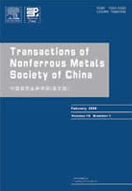Microstructure evolution and thermal stability of
nanocrystalline Cu-Nb alloys during heat treatment
nanocrystalline Cu-Nb alloys during heat treatment
(School of Materials Science and Engineering, Central South University, Changsha 410083, China)
Abstract: The microstructure evolution and high thermal stability of the mechanically-alloyed supersaturated nanocrystalline Cu-10%Nb alloy during subsequent heat treatment were investigated by X-ray diffractometry and transmission electron microscopy (TEM). The results show that no significant change of the microstructure of the solid solution can be detected after annealing at 300−400 ℃. The pronounced phase separation can be detected at 700 ℃. After annealing for 30 min at 900 ℃, almost all the Nb atoms precipitate from the solid solution, and the average Cu grain size is about 37 nm. As the solute atoms hinder the migration of fcc phase, at Cu grain boundaries, no significant grain growth occurs before large amount of Nb atoms precipitates from Cu matrix, and the decrease of internal strain and density of dislocation is small. Furthermore, the nanosized Nb precipitates can also help to reduce the Cu grains growth through precipitating pinning effect. Therefore, the mechanically-alloyed nanocrystalline Cu-Nb alloys have a high thermal stability. And the contaminations brought into the Cu matrix by milling can influence the phase formation and the thermal stability of Cu-Nb alloys during heat treatment.
Key words: Cu-Nb alloy; mechanical alloying; nanostructured material; microstructure; thermal stability

